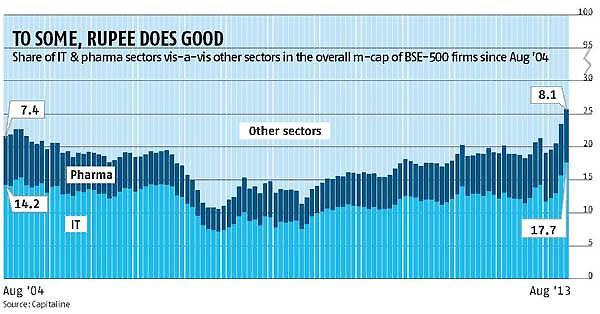Photographs: Danish Siddiqui/Reuters Krishna Kant in Mumbai
The stock market comes full circle; pharma also gains prominence, courtesy rupee depreciation
On Friday last week, brokerage firm CLSA came out with a report that said Tata Consultancy Services (TCS) was well on course to become the first company in India to have a $100-billion market capitalisation. However, the market seems to have recognised the potential of the country’s biggest software services exporter much before it caught analysts’ fancy.
Led by TCS, there has been a sharp re-rating of IT stocks on the bourses and the sector is back to being the market bellwether, much like it used to be until 2004.
The top IT exporters, accounting for 18 per cent of the combined market cap of BSE-500 companies, now lead the market.
In the process of doing so, they have displaced banks & financial services companies (16.3 per cent), which were in the driver’s seat for five years. TCS now accounts for nearly half of the IT sector’s market value and nearly seven per cent of market capitalisation of all BSE-listed companies. This makes it the most influential company on the bourses at present.
Click on NEXT for more...
2004 once more: IT back as market bellwether
Photographs: Punit Paranjpe/Reuters
At the end of April, just before the rupee began to depreciate against the dollar, the IT sector accounted for 12.2 per cent of BSE-500 companies, while banks & financials, accounting for over a fifth of index market capitalisation, led the charts (see chart).
This is revealed by an analysis of the 330 companies the month-end market capitalisation data of which are available since August 2004 (when TCS got listed on the bourses).
Until 2004, IT companies, accounting for 15.3 per cent of the combined market cap of BSE-500 firms in November 2004, were the biggest market movers. From there on, the sector’s influence began to decline, as the bull run extended to other sectors like power, capital goods, construction and infra, real estate and banks & financials, among others.
When the stock market peaked in January 2008, IT companies accounted for just seven per cent of the BSE-500 market capitalisation.
Analysts attribute the resurgence of the IT sector to rupee depreciation, which will help top IT companies like TCS, Infosys, Wipro, HCL Tech and Tech Mahindra book more rupee revenue for every dollar worth of sales.
This also makes Indian IT companies more competitive vis-a-vis their global competitors, such as IBM, Accenture, HP and Capgemini, most of whom report revenues in dollar terms.
“The money is now moving to the IT firms as these are the only ones that, aided by the rupee depreciation and demand improvement in their markets in North America and Europe, can still deliver robust growth to investors,” says Devang Mehta, senior vice-president and head (equity sales), Anand Rathi Financial Services.

Click on NEXT for more...
2004 once more: IT back as market bellwether
Photographs: Jayanta Dey/Reuters
Despite the recent run-up — TCS is up 60 per cent year to date — analysts see more upside in the sector. “We are still overweight on the sector and advising clients to increase their exposure to the sector,” says Nitin Jain, head (capital markets), Edelweiss Financial Services.
The rupee’s fall has also helped pharma companies increase their market weight. In the past year, drug firms’ share in BSE-500 market cap has risen nearly 150 basis points to 8.1 per cent at the end of August this year.
The sector’s share has more than doubled since the lows of early 2008, when it accounted for just 3.4 per cent of the entire market capitalisation of BSE-500 firms.
The rising share of export-led sectors has raised the hope that the market bottom may be near.
“IT and pharma are supporting corporate earnings at a time other sectors are likely to see stagnant profits or a decline in those. This may provide downside protection to benchmark indices like the NSE Nifty,” says Mehta.





article